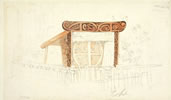Traditional Māori inheritance
In traditional Māori society leadership, land and resource rights could be inherited.
Tribal chiefs inherited mana (authority) over land and people. Mana was passed by the chief to the chosen heir – usually the eldest son of the senior wife, though he could be passed over if he was not suitable. Successors could be named by a chief on his deathbed. This was referred to as take ōhākī.
Chiefs were usually men, but women could inherit and exercise mana. This was sometimes exercised by husbands in their stead and passed on to their heirs.
Too tapu to walk
Hinematioro, a Ngāti Porou leader and woman of mana, was tapu (sacred). She did not walk but was carried in a litter from place to place so she did not make the ground tapu. Early missionary Samuel Marsden referred to her as a ‘great Queen’.1
Ancestral land was passed down through generations via continuous occupation. This was known as ahi kā (a lit fire) or ahi kā roa (a long-burning fire). It limited the number of people living in an area and using its resources. Use rights over resources such as bird-trapping trees and fishing spots were usually inherited on an individual basis. Land and use rights could be passed down by both parents to male and female children. Married women retained land independent of their husbands.
Native Land Court
After 1865 Māori land succession was overseen by the Native Land Court (later called the Māori Land Court). Until 1873 only 10 owners could be listed on land titles. These 10 were supposed to represent a larger community of owners, but in fact became the legal owners.
Land claims based on conquest rights (take raupatu) were the most successful, followed by continuous occupation (ahi kā). After 1873 all owners were listed on titles. Children could succeed to land regardless of where they lived, which disrupted the tradition of ahi kā. Some land blocks ended up having thousands of owners, which made administration difficult.
Contemporary Māori land succession
When an owner of land under Māori title dies, a succession order is made by the Māori Land Court. This transfers the land interests of the deceased to the successors. Until 1 July 1993 Māori land could be left to anyone. After this date it could only be left to blood relatives, whāngai (adopted children), spouses, partners and members of the same hapū.



